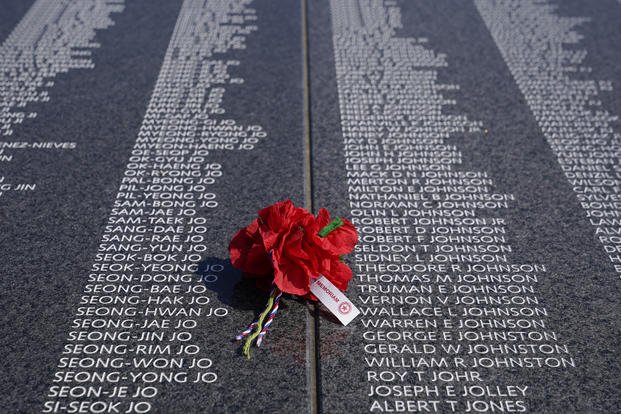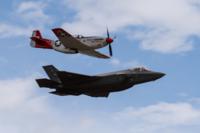Gold Star families pressed forward Tuesday to find their loved ones' names listed on the new Wall of Remembrance added to the Korean War Veterans Memorial, just as families of the fallen from Vietnam did 40 years ago at the opening of the Vietnam Veterans Memorial.
But there were major differences in how the names were arranged and who was listed between the Korea and Vietnam memorials, said retired Army Gen. John Tilelli, chairman of the Korean War Veterans Memorial Foundation.
"It's the only one [memorial] with foreign names on it," Tilelli told Military.com on a brief walk Tuesday afternoon around the circular Wall of Remembrance. That wall lists the names of more than 36,600 U.S. troops who lost their lives in the Korea conflict, along with more than 7,100 Republic of Korea (ROK) soldiers who died serving alongside them and were known as KATUSAs (Korean Augmentation To the U.S. Army).
Read Next: 3M Sets Up $1 Billion Trust to Settle Veterans' Suits over Earplugs
Tilelli, a two-tour Vietnam veteran and former commander of U.S. and ROK forces in South Korea, noted that Korean names were mixed in with the Americans, just as they had served together. "They're integrated, not separated," Tilelli said of the KATUSAs, "because they fought and died with those Americans."
He also pointed out the unusual arrangement of the names -- alphabetically and by rank and service branch -- with privates and privates first class taking up the first 44 of the 84 Army panels. They were the youngest, and "that's the cost of war, you've gotta' understand that," Tilelli said.
"It's these groups, these young men, who paid the ultimate price," he said. The name panels for the other service branches list the Americans who died, but the KATUSAs served only with the Army.
Tilelli also said several times that it was the South Korean government and its people who paid nearly the entire $22 million cost to build the Wall of Remembrance and renovate other areas of the memorial. "It would not have happened" without the funding support from South Korea, he said.
At the official dedication of the new Wall of Remembrance on Wednesday, the 69th anniversary of the armistice ending the Korean War, second gentleman Doug Emhoff represented President Joe Biden and told hundreds of guests that those who fought and died in Korea "laid the foundation for a thriving South Korea and an unbreakable U.S.-Republic of Korea alliance. Their names are now forever engraved here on our incredible National Mall."
In his remarks, Cho Tae-yong, newly nominated as the next South Korean ambassador to the U.S., said that the names of Americans and South Koreans engraved on the wall "side by side reminds us of the depth of their sacrifice" given "to ensure my country's freedom."
Cursing Gets the Job Done
One of those who could testify to the fighting ability of the KATUSAs was 91-year-old former Army Sgt. 1st Class Gates Briseno of San Francisco, who in 1952 was put in charge of four KATUSAs on the front lines near what was called Heartbreak Ridge, a few miles north of the 38th Parallel.
At first, there was a bit of a communication problem, but that was solved with the universal language of obscenity, Briseno told Military.com as the Gold Star families got their first look at the Wall of Remembrance.
"Well, you used cusswords; everybody understands cusswords," whether in English or Korean, Briseno said. "We got along fine," and "we had each other's backs" when the Chinese attacked.
"They were dropping rounds all around us", he said. At one point, he had to pull two of the KATUSAs out of a burning bunker. "I got a decoration for that," Briseno said, pointing to the Bronze Star replica ribbon pinned to his ballcap.
Gold Star family member Carol Boyer carried photographs of her uncle, Army Sgt. Charles Emory Zepp, 22, who was drafted in October 1951 and served with Company F, 2nd Battalion, 31st Infantry Regiment, 7th Infantry Division, as she waited to view the Wall of Remembrance.
Zepp, a farm boy from Severn, Maryland, went missing in action on Jan. 12, 1953, and "the area of Sgt. Zepp's loss lies in the modern-day Demilitarized Zone separating North Korea from South Korea, precluding search efforts there," according to the Defense POW/MIA Accounting Agency (DPAA).
The family knew Zepp, who is among more than 7,100 Americans still listed as missing from the Korean War, as "a kind of happy-go-lucky person," Boyer said. She also shared part of his last letter home written to his parents on Jan. 8, 1953, four days before he went missing.
He wrote about how glad he was to receive a letter from his mother telling him how good Christmas had been for the family and added, "Well, I can't think of any more to write about just now and it's almost time for me to go out on patrol." He asked that the family say "Hi" for him to friends and relatives and then signed off, "As ever, Emory."
Another Gold Star family member, retired Coast Guard Capt. Steve Froelich, 71, of Virginia was the nephew of Army Cpl. Robert Schoening, of Blaine, Washington, who served with Company C, 65th Combat Engineer Battalion, 25th Infantry Division, in Korea.
Schoening had been wounded in September 1950, was sent back to Japan to recover, and three weeks later was back with his unit, Froelich said.
Then on Nov. 27, 1950, Schoening's Company C was holding a position near Hill 222 in what is now North Korea when they came under attack by the Chinese. "Cpl. Schoening was killed during this combat and his body was not recovered at the time," according to the DPAA. But in 2000, a joint U.S./North Korean team excavated a site near Hill 222 and recovered human remains.
Froelich said the remains were later identified as those of Schoening through DNA matching, and his uncle was buried with full honors at Arlington National Cemetery in 2009.
Editor's note: This story has been updated to correct Boyer's name.
-- Richard Sisk can be reached at Richard.Sisk@Military.com.
Related: A New Addition to the Korean War Veterans Memorial Will Be Unveiled on Korean War Armistice Day















